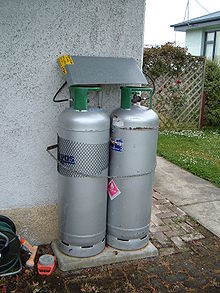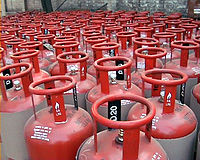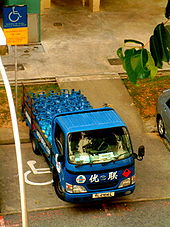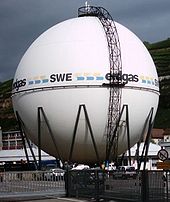- Liquefied petroleum gas
-
Liquefied petroleum gas (also called LPG, GPL, LP Gas, or liquid propane gas) is a flammable mixture of hydrocarbon gases used as a fuel in heating appliances and vehicles. It is increasingly used as an aerosol propellant and a refrigerant, replacing chlorofluorocarbons in an effort to reduce damage to the ozone layer. When specifically used as a vehicle fuel it is often referred to as autogas.
Varieties of LPG bought and sold include mixes that are primarily propane (C3H8), primarily butane (C4H10) and, most commonly, mixes including both propane and butane, depending on the season — in winter more propane, in summer more butane[citation needed]. Propylene and butylenes are usually also present in small concentration. A powerful odorant, ethanethiol, is added so that leaks can be detected easily. The international standard is EN 589. In the United States, thiophene or amyl mercaptan are also approved odorants.
LPG is synthesised by refining petroleum or "wet" natural gas, and is usually derived from fossil fuel sources, being manufactured during the refining of crude oil, or extracted from oil or gas streams as they emerge from the ground. It was first produced in 1910 by Dr. Walter Snelling, and the first commercial products appeared in 1912. It currently provides about 3% of the energy consumed, and burns cleanly with no soot and very few sulfur emissions, posing no ground or water pollution hazards. LPG has a typical specific calorific value of 46.1 MJ/kg compared with 42.5 MJ/kg for fuel-oil and 43.5 MJ/kg for premium grade petrol (gasoline).[1] However, its energy density per volume unit of 26 MJ/l is lower than either that of petrol or fuel-oil.[citation needed]
LPG evaporates quickly at normal temperatures and pressures and is supplied in pressurised steel cylinders. They are typically filled to between 80% and 85% of their capacity to allow for thermal expansion of the contained liquid. The ratio between the volumes of the vaporized gas and the liquefied gas varies depending on composition, pressure, and temperature, but is typically around 250:1. The pressure at which LPG becomes liquid, called its vapour pressure, likewise varies depending on composition and temperature; for example, it is approximately 220 kilopascals (2.2 bar) for pure butane at 20 °C (68 °F), and approximately 2.2 megapascals (22 bar) for pure propane at 55 °C (131 °F). LPG is heavier than air, and thus will flow along floors and tend to settle in low spots, such as basements. This can cause ignition or suffocation hazards if not dealt with.
Large amounts of LPG can be stored in bulk cylinders and can be buried underground.
Contents
Uses
Rural heating
Predominantly in Europe and rural parts of the United States, LPG can provide an alternative to electricity and heating oil (kerosene). LPG is most often used where there is no access to piped natural gas.
LPG can be used as a power source for combined heat and power technologies (CHP). CHP is the process of generating both electrical power and useful heat from a single fuel source. This technology has allowed LPG to be used not just as fuel for heating and cooking, but also for de-centralised generation of electricity.
LPG can be stored in a variety of ways. LPG, as with other fossil fuels, can be combined with renewable power sources to provide greater reliability while still achieving some reduction in CO2 emissions.
Motor fuel
When LPG is used to fuel internal combustion engines, it is often referred to as autogas or auto propane. In some countries, it has been used since the 1940s as a petrol alternative for spark ignition engines. Two recent studies have examined LPG-fuel-oil fuel mixes and found that smoke emissions and fuel consumption are reduced but hydrocarbon emissions are increased.[2][3] The studies were split on CO emissions, with one finding significant increases,[2] and the other finding slight increases at low engine load but a considerable decrease at high engine load.[3] Its advantage is that it is non-toxic, non-corrosive and free of tetra-ethyl lead or any additives, and has a high octane rating (102-108 RON depending on local specifications). It burns more cleanly than petrol or fuel-oil and is especially free of the particulates from the latter.
LPG has a lower energy density than either petrol or fuel-oil, so the equivalent fuel consumption is higher. Many governments impose less tax on LPG than on petrol or fuel-oil, which helps offset the greater consumption of LPG than of petrol or fuel-oil. However, in many European countries this tax break is often compensated by a much higher annual road tax on cars using LPG than on cars using petrol or fuel-oil. Propane is the third most widely used motor fuel in the world. 2008 estimates are that over 13 million vehicles are fueled by propane gas worldwide. Over 20 million tonnes (over 7 billion US gallons) are used annually as a vehicle fuel.
Not all automobile engines are suitable for use with LPG as a fuel. LPG provides less upper cylinder lubrication than petrol or diesel, as a consequence LPG fueled engines are more prone to wearing valves if not suitably modified. Many modern common rail diesel engines respond well to LPG use as a supplementary fuel. This is where LPG is used as fuel as well as diesel. Systems are now available that integrate with OEM engine management systems.
Refrigeration
LPG is instrumental in providing off-the-grid refrigeration, usually by means of a gas absorption refrigerator.
Blended of pure, dry "isopropane" (refrigerant designator R-290a ) and isobutane (R-600a) have negligible ozone depletion potential and very low global warming potential and can serve as a functional replacement for R-12, R-22, R-134a,and other chlorofluorocarbon or hydrofluorocarbon refrigerants in conventional stationary refrigeration and air conditioning systems.[4]
Such substitution is widely prohibited or discouraged in motor vehicle air conditioning systems, on the grounds that using flammable hydrocarbons in systems originally designed to carry non-flammable refrigerant presents a significant risk of fire or explosion.[5][6][7][8][9][10][11][12]
Vendors and advocates of hydrocarbon refrigerants argue against such bans on the grounds that there have been very few such incidents relative to the number of vehicle air conditioning systems filled with hydrocarbons.[13][14] One particular test was conducted by a professor at the University of New South Wales that unintentionally tested the worst case scenario of a sudden and complete refrigerant loss into the passenger compartment followed by subsequent ignition. He and several others in the car sustained minor burns to their face, ears, and hands, and several observers received lacerations from the burst glass of the front passenger window. No one was seriously injured.[15]
Cooking
According to the 2001 Census of India, 17.5% of Indian households or 33.6 million Indian households used LPG as cooking fuel in 2001, which is supplied to to their homes by Indian Oil which is known as Indane.[16] 76.64% of such households were from urban India making up 48% of urban Indian households as compared to a usage of 5.7% only in rural Indian households. LPG is subsidised by the government. Increase in LPG prices has been a politically sensitive matter in India as it potentially affects the urban middle class voting pattern.
LPG was once a popular cooking fuel in Hong Kong; however, the continued expansion of town gas to buildings has reduced LPG usage to less than 24% of residential units.
LPG is the most common cooking fuel in Brazilian urban areas, being used in virtually all households. Poor families receive a government grant ("Vale Gás") used exclusively for the acquisition of LPG.
Security of supply
Because of the natural gas and the oil-refining industry, Europe is almost self-sufficient in LPG. Europe's security of supply is further safeguarded by:
- a wide range of sources, both inside and outside Europe;
- a flexible supply chain via water, rail and road with numerous routes and entry points into Europe;
As of early 2008, world reserves of natural gas — from which most LPG is derived — stood at 6,342.411 trillion cubic feet. Added to the LPG derived from cracking crude oil, this amounts to a major energy source that is virtually untapped and has massive potential. Production continues to grow at an average annual rate of 2.2%, virtually assuring that there is no risk of demand outstripping supply for the foreseeable future.[citation needed]
Comparison with natural gas
LPG is composed primarily of propane and butane, while natural gas is composed of the lighter methane and ethane. LPG, vaporised and at atmospheric pressure, has a higher calorific value (94 MJ/m3 equivalent to 26.1kWh/m³) than natural gas (methane) (38 MJ/m3 equivalent to 10.6 kWh/m3), which means that LPG cannot simply be substituted for natural gas. In order to allow the use of the same burner controls and to provide for similar combustion characteristics, LPG can be mixed with air to produce a synthetic natural gas (SNG) that can be easily substituted. LPG/air mixing ratios average 60/40, though this is widely variable based on the gases making up the LPG. The method for determining the mixing ratios is by calculating the Wobbe index of the mix. Gases having the same Wobbe index are held to be interchangeable.
LPG-based SNG is used in emergency backup systems for many public, industrial and military installations, and many utilities use LPG peak shaving plants in times of high demand to make up shortages in natural gas supplied to their distributions systems. LPG-SNG installations are also used during initial gas system introductions, when the distribution infrastructure is in place before gas supplies can be connected. Developing markets in India and China (among others) use LPG-SNG systems to build up customer bases prior to expanding existing natural gas systems.
Environmental Effects
Commercially available LPG is currently derived from fossil fuels. Burning LPG releases CO2, an important greenhouse gas, contributing to global warming. LPG does, however, release less CO2 per unit of energy than that of coal or oil. It emits 81% of the CO2 per kWh produced by oil, 70% of that of coal, and less than 50% of that emitted by coal-generated electricity distributed via the grid.[citation needed] Being a mix of propane and butane, LPG emits less carbon per joule than butane but more carbon per joule than propane.
LPG can be considered to burn more 'cleanly' than heavier molecule hydrocarbons, in that it releases very few particulates when burnt.
Fire risk and mitigation
Since LPG turns gaseous under ambient temperature and pressure, it must be stored in special pressure vessels. If the containers are cylindrical and horizontal, they are referred to as "cigars" or "bullets", whereas circular ones are "spheres".
LPG containers that are subjected to fire of sufficient duration and intensity can undergo a boiling liquid expanding vapour explosion (BLEVE). Due to the destructive nature of LPG explosions, the substance is classified as a dangerous good.[17] This is typically a concern for large refineries and petrochemical plants that maintain very large containers. The remedy is to equip such containers with a measure to provide a fire-resistance rating. Large, spherical LPG containers may have up to a 15 cm steel wall thickness. Ordinarily, they are equipped with an approved pressure relief valve on the top, in the centre. One of the main dangers is that accidental spills of hydrocarbons may ignite and heat an LPG container, which increases its temperature and pressure, following the basic gas laws. The relief valve on the top is designed to vent off excess pressure in order to prevent the rupture of the container itself. Given a fire of sufficient duration and intensity, the pressure being generated by the boiling and expanding gas can exceed the ability of the valve to vent the excess. When that occurs, an overexposed container may rupture violently, launching pieces at high velocity, while the released products can ignite as well, potentially causing catastrophic damage to anything nearby, including other containers. In the case of "cigars", a midway rupture may send two "rockets" going off each way, with plenty of fuel in each to propel each segment at high speed until the fuel is spent.
Mitigation measures include separating LPG containers from potential sources of fire. In the case of rail transport, for instance, LPG containers can be staggered, so that other goods are put in between them. This is not always done, but it does represent a low-cost remedy to the problem. LPG rail cars are easy to spot from the relief valves on top, typically with railings all around.
In the case of new LPG containers, one may simply bury them, only leaving valves and armatures exposed, for easy maintenance. Great care must be taken there though, as mechanical damage can occur to the primers, which can result in hazardous corrosion of the containers. For the buried container, only the exposed parts need to be treated with approved fireproofing materials, such as intumescent and or endothermic coatings, or even fireproofing plasters. The rest are amply protected by soil. Speciality removable covers exist for easy access to the dials and components that must be accessed for proper maintenance and operation of the equipment. LPG containers are subject to significant motion due to expansion, contraction, filling and emptying; even with very thick steel walls. This operational motion makes the burial option less attractive in the long run, because it is difficult to detect mechanical damage to the outer waterproofing of the vessel through soil. A small stone scraping back and forth across the epoxy-painted hull can jeopardise the waterproofing and be the cause for corrosion.
Whilst one may calculate and justify on paper the use of inorganic plasters to cover entire spheres, it can be difficult to keep plasters operable for extended periods of time. Major errors have also been made in the past in this field, as the presumption was that the steel substrate would be adequately protected from rusting through the use of alkaline plasters. The alkalinity in such plasters is due to the presence of cement stone. This alkalinity, however, does not typically have a permanent character, which means that waterproofing with high quality epoxy primers is very important. Also, exterior waterproofing of the plaster is required by some fireproofing plaster vendors, as reduced alkalinity in exposed plasters can have a deleterious effect on the cement stone, which binds the plaster in the first place. By contrast, the intumescent and endothermic coatings are usually epoxy based to begin with, meaning that corrosion of the substrate is no problem whatsoever.
Fireproofing, not unlike all passive fire protection products, is subject to stringent Listing and approval use and compliance. The problem with this is though, that exterior structures of this nature are not subject to the building code or the fire code, meaning that one still sees the majority of LPG containers without any fireproofing at all, as there are often no local regulations, let alone any Authority Having Jurisdiction, apart from an insurance inspector, to force owners to use the proper mitigation methods. Insurance companies are also in a competitive quandary, where such items are concerned, as they compete not only on the basis of rates, but also on the strictness of the demands by their inspectors. LPG vessel fireproofing tests are varied. The only realistic exposure offered is done at the Braunschweig test facility of "BAM" Berlin. BAM's procedure is to expose a small LPG container to the hydrocarbon test curve and to quantify the results. North American methods are based on UL1709. While UL1709 uses the correct time/temperature curve for testing, it is limited to testing steel columns (not even beams), whereas BAM actually exposes a real LPG container that has been fireproofed. No matter the fireproofing method one uses, it is very important to pay close attention to listing and approval use and compliance and to be sure that the product one chooses has undergone product certification, whereby the original test included the environmental exposures that the product will be exposed to during operations. Particularly with organic products, such as the endothermic and intumescent ones, one must closely review the ageing criteria and be able to quantify how long the product is expected to be operable for. This is where UL1709 "shines". Anything that can withstand the full battery of environmental exposures prior to the actual fire test, is a very tough product indeed. The idea is to rule out conditions that may render the product inoperable before it is ever exposed to a fire. By using products that have received the appropriate environmental tests FIRST, and the fire expose afterwards, using the very same test sample with all the applicable exposures, one can then demonstrate due diligence, but not otherwise. Likewise, the DIBt ageing qualifications for intumescents have proven to be very reliable. With close attention to the bounding and coverage of ageing and environmental exposures, it is absolutely possible to buy a lot of time for firefighting measures to relieve the LPG containers of the energy exposure from accidental fires and thus reduce the likelihood of a BLEVE to the maximum possible extent.
In June 2009, a freight train carrying LPG derailed in the rail station of Viareggio, Italy. 29 people were killed and over 30 people were injured.
See also
- Listing and approval use and compliance
- Blau gas
- Compressed natural gas (CNG)
- Endothermic
- Filling Carousel
- Fireproofing
- Fire-resistance rating
- Gasoline gallon equivalent
- Hybrid vehicles and Hybrid electric vehicles
- Intumescent
- Industrial gas
- Liquefied natural gas (LNG)
- Natural gas
- Passive fire protection
- Product certification
- Underwriters Laboratories
- World LP Gas Association
- List of CO2 emitted per million Btu of energy from various fuels
References
- ^ Horst Bauer, ed (1996). Automotive Handbook (4th ed.). Stuttgart: Robert Bosch GmbH. pp. 238–239. ISBN 0837603331.
- ^ a b Zhang, Chunhua; Bian, Yaozhang; Si, Lizeng; Liao, Junzhi; Odbileg, N (2005). "A study on an electronically controlled liquefied petroleum gas-diesel dual-fuel automobile". Proceedings of the Institution of Mechanical Engineers, Part D: Journal of Automobile Engineering 219 (2): 207. doi:10.1243/095440705X6470.
- ^ a b Qi, D; Bian, Y; Ma, Z; Zhang, C; Liu, S (2007). "Combustion and exhaust emission characteristics of a compression ignition engine using liquefied petroleum gas–fuel-oil blended fuel". Energy Conversion and Management 48 (2): 500. doi:10.1016/j.enconman.2006.06.013.
- ^ "European Commission on retrofit refrigerants for stationary applications" (PDF). http://ec.europa.eu/environment/ozone/pdf/hcfc_technical_meeting_summary.pdf. Retrieved 2009-07-30.
- ^ "U.S. EPA hydrocarbon-refrigerants FAQ". United States Environmental Protection Agency. http://www.epa.gov/ozone/snap/refrigerants/hc12alng.html. Retrieved 2009-07-30.
- ^ Compendium of hydrocarbon-refrigerant policy statements, October 2006[dead link]
- ^ "MACS bulletin: hydrocarbon refrigerant usage in vehicles" (PDF). http://www.autoacforum.com/MACS/HCwarning.pdf. Retrieved 2009-07-30.
- ^ "Society of Automotive Engineers hydrocarbon refrigerant bulletin". Sae.org. 2005-04-27. http://www.sae.org/news/releases/05hydrocarbon_warning.htm. Retrieved 2009-07-30.
- ^ "Shade Tree Mechanic on hydrocarbon refrigerants". Electromechanics.com. 2005-04-27. http://www.shadetreemechanic.com/cc_hydrocarbon_refrigerants.htm. Retrieved 2009-07-30.
- ^ "Saskatchewan Labor bulletin on hydrocarbon refrigerants in vehicles". Labour.gov.sk.ca. 1996-01-01. http://www.labour.gov.sk.ca/Default.aspx?DN=2fb5ac24-d90e-4408-bf40-559793bd8e96. Retrieved 2009-07-30.
- ^ VASA on refrigerant legality & advisability[dead link]
- ^ "Flammable Refrigerant Alert" (PDF). http://www.energy.qld.gov.au/zone_files/petroleum_pdf/safety_alert025.pdf. Retrieved 2009-07-30.
- ^ "New South Wales (Australia) Parliamentary record, 16 October 1997". Parliament.nsw.gov.au. 1997-10-16. http://www.parliament.nsw.gov.au/prod/parlment/HansArt.nsf/V3Key/LA19971016015. Retrieved 2009-07-30.
- ^ "New South Wales (Australia) Parliamentary record, 29 June 2000". Parliament.nsw.gov.au. http://www.parliament.nsw.gov.au/prod/parlment/hansart.nsf/V3Key/LC20000629051. Retrieved 2009-07-30.
- ^ VASA news report on hydrocarbon refrigerant demonstrations[dead link]
- ^ "Indian Census". Censusindia.gov.in. http://www.censusindia.gov.in/. Retrieved 2009-07-30.
- ^ The Dangerous Substances and Explosive Atmospheres Regulations. Retrieved on 27 June 2007.
External links
- WLPGA World LP Gas Association
- PERC Propane Education & Research Council
- NPGA National Propane Gas Association, USA
- Propane 101 Explaining propane and LP Gas fundamentals
Categories:- Liquefied petroleum gas
- Petroleum production
Wikimedia Foundation. 2010.





